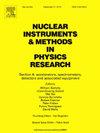揭示短程磁相关性:CSNS 磁对分布函数方法的发展
IF 1.5
3区 物理与天体物理
Q3 INSTRUMENTS & INSTRUMENTATION
Nuclear Instruments & Methods in Physics Research Section A-accelerators Spectrometers Detectors and Associated Equipment
Pub Date : 2024-10-09
DOI:10.1016/j.nima.2024.169967
引用次数: 0
摘要
磁对分布函数(mPDF)分析中子全散射数据的最新进展为研究材料中的局部磁相关性提供了一种强有力的方法。这项技术有望直接在现实空间中揭示亚纳米长度尺度的短程磁相关性。它尤其适用于强相关电子系统和几何失谐磁体。在本研究中,mPDF 实验是在中国溅射中子源的多物理场仪器(MPI)上进行的,该仪器是世界上最新的中子全散射衍射仪之一。我们系统地评估了在 MPI 和类似仪器上进行 mPDF 实验时与实验装置和数据处理相关的一系列重要参数。这种方法不仅推进了基础材料的磁结构测定,而且为将 mPDF 研究扩展到对传统衍射方法具有挑战性的更复杂和更前沿的磁系统打开了大门。本文章由计算机程序翻译,如有差异,请以英文原文为准。
Unveiling short-range magnetic correlations: The development of magnetic pair distribution function method at CSNS
Recent advancements in the magnetic pair distribution function (mPDF) analysis of neutron total scattering data provide a powerful approach to investigate local magnetic correlations in materials. This technique is promising for revealing short-range magnetic correlations at the sub-nanometer length scale directly in real space. It is particularly suitable for strongly correlated electron systems and geometrically frustrated magnets. In this study, the mPDF experiment is conducted at the multi-physics instrument (MPI) of the China Spallation Neutron Source, one of the latest neutron total scattering diffractometers in the world. We systematically benchmarked a series of important parameters related to the experimental setup and data processing for mPDF experiments at the MPI and similar instruments. This method not only advances the magnetic structure determination of fundamental materials but also opens the door for extending mPDF studies to more complicated and frontier magnetic systems that are challenging for conventional diffraction methods.
求助全文
通过发布文献求助,成功后即可免费获取论文全文。
去求助
来源期刊
CiteScore
3.20
自引率
21.40%
发文量
787
审稿时长
1 months
期刊介绍:
Section A of Nuclear Instruments and Methods in Physics Research publishes papers on design, manufacturing and performance of scientific instruments with an emphasis on large scale facilities. This includes the development of particle accelerators, ion sources, beam transport systems and target arrangements as well as the use of secondary phenomena such as synchrotron radiation and free electron lasers. It also includes all types of instrumentation for the detection and spectrometry of radiations from high energy processes and nuclear decays, as well as instrumentation for experiments at nuclear reactors. Specialized electronics for nuclear and other types of spectrometry as well as computerization of measurements and control systems in this area also find their place in the A section.
Theoretical as well as experimental papers are accepted.

 求助内容:
求助内容: 应助结果提醒方式:
应助结果提醒方式:


